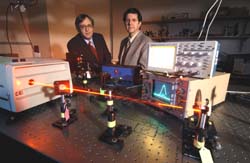This special field revolves around processes for modifying material properties (milling, cooling), composition (filtration, distillation) and type (oxidation, hydration).
Valuable information is available on a broad range of technologies including material separation, laser processes, measuring techniques and robot engineering in addition to testing methods and coating and materials analysis processes.

Millions of land mines are buried worldwide, and these weapons were responsible for an estimated 16,000 injuries and deaths in 2002.
Georgia Institute of Technology researchers are making progress with a landmine detection system that could ultimately help prevent such losses. The system uses high-frequency seismic waves to displace soil and objects in it slightly (less than one ten-thousandth of an inch). A non-contacting radar sensor then measures the results, creating a visual

Microwaves could provide a safe new way of finding hidden weapons and buried mines, thanks to UK research.
Scientists are developing a microwave-based technique that can generate high-quality images of hidden objects. The research may lead to the use of microwaves as a safer alternative to X-rays in airport security checks, building searches, landmine detection and other applications.
This leading-edge work is being carried out by a team of engineers and physicists at Northu

Thanks in part to highly accurate measurements made by National Institute of Standards and Technology (NIST) researchers, semiconductor manufacturers will be able to pursue a new production method that will enable them to produce new generations of computer chips using existing equipment—saving the industry hundreds of millions of dollars.
Creating ever more powerful computer chips relies on being able to increasingly miniaturize the features on those chips. Industry had thought it might

A three-dimensional microfabrication technique that uses a unique class of light-activated molecules to selectively initiate chemical reactions within polymers and other materials could provide an efficient way to produce complex structures with sub-micron features.
Known as “two-photon 3D lithography,” the technique could compete with existing processes for fabricating microfluidic devices, photonic bandgap structures, optical storage devices, photonic switches and couplers, sensors, actuat

Researchers have created a portable, chip-size version of a detection system that is commonly used by industry and law enforcement to identify everything from agricultural toxins to DNA.
The miniature detector could move certain types of testing from the lab into the field, saving time and money while increasing security.
The team, which used a newly developed laser-processing technique to create the miniature detector, was supported by the National Science Foundation and led by a P

In Treibstoffen enthaltene Schwefel- und Stickstoff-Verbindungen setzen bei der Verbrennung Schwefel- und Stickoxide frei, die die Umwelt belasten. Daher wird immer größerer Wert darauf gelegt, dass Benzin, Diesel und Kerosin möglichst frei von diesen Stoffen sind.
Forscher der University of Michigan haben eine neue Methode entwickelt, um unliebsame Stickstoffverbindungen aus Diesel zu entfernen. Ralph T. Yang und Arturo J. Hernández-Maldonado suchten nach einer adsorptiven Methode, um stör